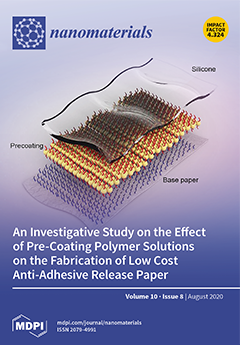Reduced graphene oxide (RGO) was synthesized in this research via Tour’s method for the use of filler in the hydrogel matrix. The copolymerization of
N,
N-dimethylacrylamide (DMA) onto the gum tragacanth (GT) was carried out to develop gum tragacanth-cl-
N,
N-dimethylacrylamide (GT-cl-poly(DMA)) hydrogel using
N,
N’-methylenebisacrylamide (NMBA) and potassium persulfate (KPS) as cross-linker and initiator correspondingly. The various GT-cl-poly(DMA) hydrogel synthesis parameters were optimized to achieve maximum swelling of GT-cl-poly(DMA) hydrogel. The optimized GT-cl-poly(DMA) hydrogel was then filled with RGO to form reduced graphene oxide incorporated gum tragacanth-cl-
N,
N-dimethylacrylamide (GT-cl-poly(DMA)/RGO) hydrogel composite. The synthesized samples were used for competent adsorption of Hg
2+ and Cr
6+ ions. Fourier transform infrared, X-ray powder diffraction, field emission scanning electron microscopy, energy-dispersive X-ray spectroscopy were used to characterize the gum tragacanth-cl-
N,
N-dimethylacrylamide hydrogel and reduced graphene oxide incorporated gum tragacanth-cl-
N,
N-dimethylacrylamide hydrogel composite. The experiments of adsorption-desorption cycles for Hg
2+ and Cr
6+ ions were carried out to perform the reusability of gum tragacanth-cl-
N,N-dimethylacrylamide hydrogel and reduced graphene oxide incorporated gum tragacanth-cl-
N,N-dimethylacrylamide hydrogel composite. From these two samples, reduced graphene oxide incorporated gum tragacanth-cl-
N,N-dimethylacrylamide exhibited high adsorption ability. The Hg
2+ and Cr
6+ ions adsorption by gum tragacanth-cl-
N,N-dimethylacrylamide and reduced graphene oxide incorporated gum tragacanth-cl-
N,N-dimethylacrylamide were best suited for pseudo-second-order kinetics and Langmuir isotherm. The reported maximum Hg
2+ and Cr
6+ ions adsorption capacities were 666.6 mg g
-1 and 473.9 mg g
-1 respectively.
Full article






